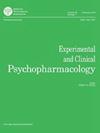将回归树应用于研究大学生中与酒精有关的问题。
IF 2.4
3区 医学
Q3 PHARMACOLOGY & PHARMACY
引用次数: 0
摘要
机器学习算法有望为成瘾治疗开发精准医疗方法,但却很少用于识别酒精相关问题的预测因素。递归分区是一种机器学习算法,可识别显著的预测因子和临床切点,从而指导治疗。本研究旨在识别酒精相关问题的预测因子和切点,并在两个独立的大学生饮酒者大型数据集(n = 5,090 和 2,808)中检验结果的稳定性。使用 R 软件包 "rpart "建立了四棵回归树。71 个预测因子被归类为人口统计学指标(如年龄)、酒精使用指标(如典型数量/频率)或社会心理指标(如焦虑)。提取的预测因子和切点用于在其他数据集中手动重建树,以测试结果的稳定性。结果变量为酒精相关问题,由酒精使用障碍识别测试和青年酒精后果简明问卷测量。在四棵树中,应对抑郁、顺从动机、暴饮暴食频率、典型/最大量饮酒、醉酒频率、严重减少伤害的保护性行为策略、药物使用和精神病症状对酒精相关问题的预测效果最好;应对抑郁(切点范围:1.83-2.17)和暴饮暴食频率(切点范围:1.5-2.5)是最常见的分裂变量。模型拟合指数表明结果相对稳定,占方差的 17%-30%。结果表明,九个突出的预测因素,尤其是应对抑郁动机得分在2分左右和每月暴饮频率在2-3次左右,是治疗大学生酒精相关问题时需要考虑的重要目标。(PsycInfo Database Record (c) 2024 APA, 版权所有)。本文章由计算机程序翻译,如有差异,请以英文原文为准。
Regression tree applications to studying alcohol-related problems among college students.
Machine learning algorithms hold promise for developing precision medicine approaches to addiction treatment yet have been used sparingly to identify predictors of alcohol-related problems. Recursive partitioning, a machine learning algorithm, can identify salient predictors and clinical cut points that can guide treatment. This study aimed to identify predictors and cut points of alcohol-related problems and to examine result stability in two separate, large data sets of college student drinkers (n = 5,090 and 2,808). Four regression trees were grown using the "rpart" package in R. Seventy-one predictors were classified as demographics (e.g., age), alcohol use indicators (e.g., typical quantity/frequency), or psychosocial indicators (e.g., anxiety). Predictors and cut points were extracted and used to manually recreate the tree in the other data set to test result stability. Outcome variables were alcohol-related problems as measured by the Alcohol Use Disorder Identification Test and Brief Young Adult Alcohol Consequences Questionnaire. Coping with depression, conformity motives, binge drinking frequency, typical/heaviest quantity, drunk frequency, serious harm reduction protective behavioral strategies, substance use, and psychosis symptoms best predicted alcohol-related problems across the four trees; coping with depression (cut point range: 1.83-2.17) and binge drinking frequency (cut point range: 1.5-2.5) were the most common splitting variables. Model fit indices suggest relatively stable results accounting for 17%-30% of the variance. Results suggest the nine salient predictors, particularly coping with depression motives scores around 2 and binge drinking frequency around two to three times per month, are important targets to consider when treating alcohol-related problems for college students. (PsycInfo Database Record (c) 2024 APA, all rights reserved).
求助全文
通过发布文献求助,成功后即可免费获取论文全文。
去求助
来源期刊
CiteScore
4.20
自引率
8.70%
发文量
164
审稿时长
6-12 weeks
期刊介绍:
Experimental and Clinical Psychopharmacology publishes advances in translational and interdisciplinary research on psychopharmacology, broadly defined, and/or substance abuse.

 求助内容:
求助内容: 应助结果提醒方式:
应助结果提醒方式:


